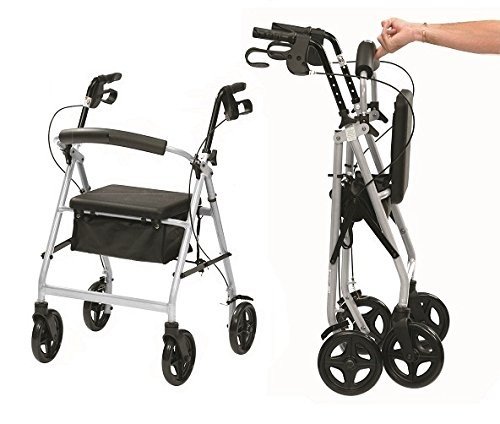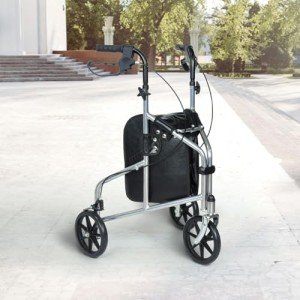
9
MayGuide To Rollator With Brakes: The Intermediate Guide The Steps To Rollator With Brakes
Understanding Rollators with Brakes: A Comprehensive Guide
As people age or experience mobility difficulties, daily jobs can become increasingly challenging. A Bariatric Rollator with brakes is a mobility aid designed to improve self-reliance and safety for users. These tools not only supply support while walking but also come equipped with brakes that ensure stability and control. This short article dives into the features, benefits, and factors to consider for picking a rollator with brakes, in addition to often asked questions to help potential users make informed choices.
What is a Rollator?
A rollator is a mobility aid that typically includes a wheeled frame with handgrips, a seat, and, most notably, brakes. Designed for people who require some help while walking, rollators provide stability, support, and a practical way to rest when needed.

Key Features of Rollators
- Wheels: Most rollators have 4 wheels, which enable smoother movement over various terrains.
- Brakes: Handles connected to brakes permit users to control speed and stop securely when needed.
- Seat: A built-in seat offers an alternative for users to rest when tired out.
- Storage: Many models consist of baskets or pouches for bring individual products.
Benefits of Using a Rollator with Brakes
Using a rollator with brakes provides numerous advantages, including:
- Enhanced Safety: The brakes offer stability, preventing falls.
- Self-reliance: Users can move about without assistance, promoting autonomy.
- Convenience: Built-in storage allows people to bring their personal belongings easily.
- Versatility: Suitable for both indoor and outdoor use.
Types of Rollators with Brakes
Rollators are available in various designs to accommodate different user requirements. The following prevail types of rollators with brakes:
- Standard Rollators: Equipped with 4 wheels, these are appropriate for most users who require fundamental support.
- Heavy-Duty Rollators: Designed for larger people, these rollators include enhanced frames to provide trusted assistance.
- Compact Rollators: Costway Lightweight Folding Walker with Seat & Brakes and foldable, compact rollators are ideal for travel.
- Three-Wheel Rollators: A versatile alternative for steering tight spaces, three-wheel models provide ease of motion.
| Kind of Rollator | Key Features | Best Suited For |
|---|---|---|
| Requirement Rollator | 4 wheels, fundamental performance | General users |
| Durable Rollator | Reinforced frame, durable products | Larger people |
| Compact Rollator | Lightweight, foldable design | Travel and mobility |
| Three-Wheel Rollator | Smaller turning radius, easy mobility | Minimal spaces |
Elements to Consider When Choosing a Rollator with Brakes
Choosing the right rollator requires consideration of several factors. Here are important elements to keep in mind:
- Weight Capacity: Verify the Ergonomic Rollator's weight limit to guarantee it is safe for the user.
- Handle Height: Adjustable manages permit personalization to match specific height needs.
- Wheel Size: Larger wheels perform better on irregular surfaces, while smaller sized wheels offer dexterity in tight spaces.
- Folding Ability: If travel is a factor to consider, search for a design that is simple to fold and save.
- Braking Mechanism: Different models might include various braking systems (e.g., push-to-lock, pull-to-release). Select one that lines up with user convenience.
Maintenance Tips for Rollators with Brakes
Correct maintenance guarantees longevity and optimum performance. Follow these standards to keep a rollator in outstanding condition:
- Regular Cleaning: Wipe down the frame and look for built up dirt and debris.
- Examine Wheels: Ensure wheels are free from obstruction and are correctly inflated if pneumatic.
- Test Brakes: Regularly examine if brakes engage and disengage smoothly.
- Change Handles: Make periodic modifications to ensure the deal with height remains appropriate for the user.
Often Asked Questions (FAQs)
Q1: Are rollators appropriate for outdoor use?A1: Yes
, numerous rollators are designed for both indoor and outdoor use. Those with bigger wheels tend to perform better on uneven surface areas.
Q2: Can rollators fold for easy storage?A2: Most rollators feature a folding feature, making them easy to shop and transport. Q3: How do I understand if a rollator is
safe for me?A3: Ensure the weight capacity meets your needs,
and adjust the manage height for correct ergonomics. Consulting a doctor for recommendations is also suggested. Q4: Can I use a rollator with brakes on stairs?A4: Rollators are not created
for use on stairs. For stair navigation,
people should seek other approaches of support, like handrails or stair lifts. Q5: How do I take care of a rollator with brakes?A5: Regular cleaning, inspecting for wear and tear, and examining the braking system are essential steps for maintenance. Rollators with brakes represent an essential mobility aid for people looking for enhanced independence and safety. As users assess their options
, understanding the various types, functions, and upkeep requirements will guarantee they select the very best rollator for their needs. With correct care and use, a rollator can significantly boost one's mobility, contributing to better quality of life and greater flexibility in day-to-day activities.
Reviews